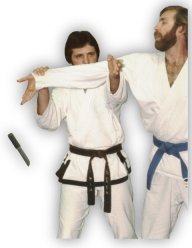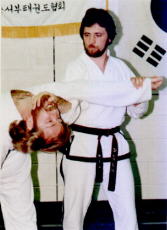If when confronted by an opponent who has a weapon, you
are unable to reason with him or walk away peaceably, then
you must be prepared to defend yourself or face the consequences.
 No matter how small your opponent may be, if he has a
weapon he has a distinct advantage over you. He will be able
to strike you while remaining outside your defensive sphere.
A club, even in the hands of a novice, can become a deadly
weapon. Therefore, when you begin to take action to defend
yourself, you must act decisively and without hesitation. You
must either draw your antagonist into your defensive sphere
or move along one of the angles of evasion, so that you will
be able to control the weapon and neutralize your opponent.
No matter how small your opponent may be, if he has a
weapon he has a distinct advantage over you. He will be able
to strike you while remaining outside your defensive sphere.
A club, even in the hands of a novice, can become a deadly
weapon. Therefore, when you begin to take action to defend
yourself, you must act decisively and without hesitation. You
must either draw your antagonist into your defensive sphere
or move along one of the angles of evasion, so that you will
be able to control the weapon and neutralize your opponent.
When defending against a weapon attack you should
follow the rules of defensive action in their precise chronological
order:
- Evade the attack by drawing the opponent into
your defensive sphere or moving along one of the
angles of evasion.
- Control the weapon. Use trapping techniques, joint
locks or manipulations, strikes, or off-balancing
techniques.
- Neutralize the opponent. This may be accomplished
by disarming him and counter-attacking, using his
weapon against him or striking vital parts of the
body. Throws and projections are also methods of
neutralization and may be used at this point.
When defending against an opponent who has a knife,
controlling the weapon is of the utmost importance. Soft blocks,
and circular movements should be used when subduing him.
Re-direct or evade the weapon while following up with a technique
of neutralization.

When disarming an opponent who is using a knife, you will
not, in most situations, use the weapon against him, as can
be done in club defenses. When defending against club attacks
you are able to grab the end of the weapon and quite easily
disarm him. With a knife that same situation does not exist.
Your opponent will be holding the only area of the knife which
can be grabbed safely. The only time you will be able to actually
take the knife away from him and use it against him is while
executing detailed joint manipulation techniques. Normally,
the weapon will fall to the ground, at which point you
will promptly follow up with a technique of neutralization.
When practicing weapon defenses you should do so under the direct
supervision of a qualified instructor. You should practice with a
rubber or wooden knife NEVER with a real knife. When executing
a disarm technique apply pressure to the joints slowly and
stop the technique as soon as your partner signals you that there is
pain or too much pressure being exerted. The pain tells you your
opponent would have dropped the knife at that point. Safety,
concentration, and preciseness are key factors in determining the
effectiveness of your defenses.